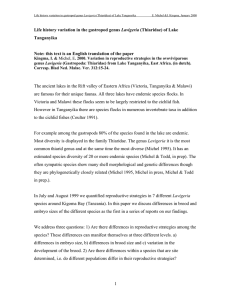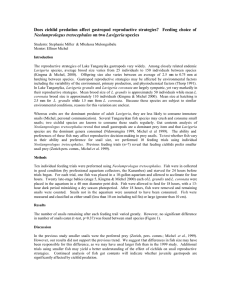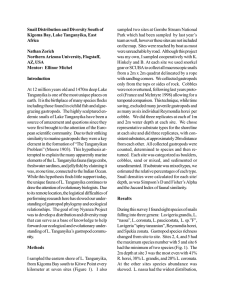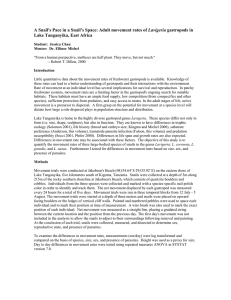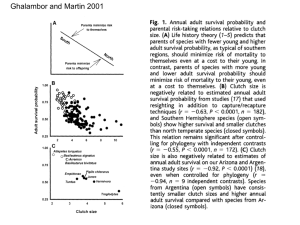Lavigeria embryo sizes
advertisement
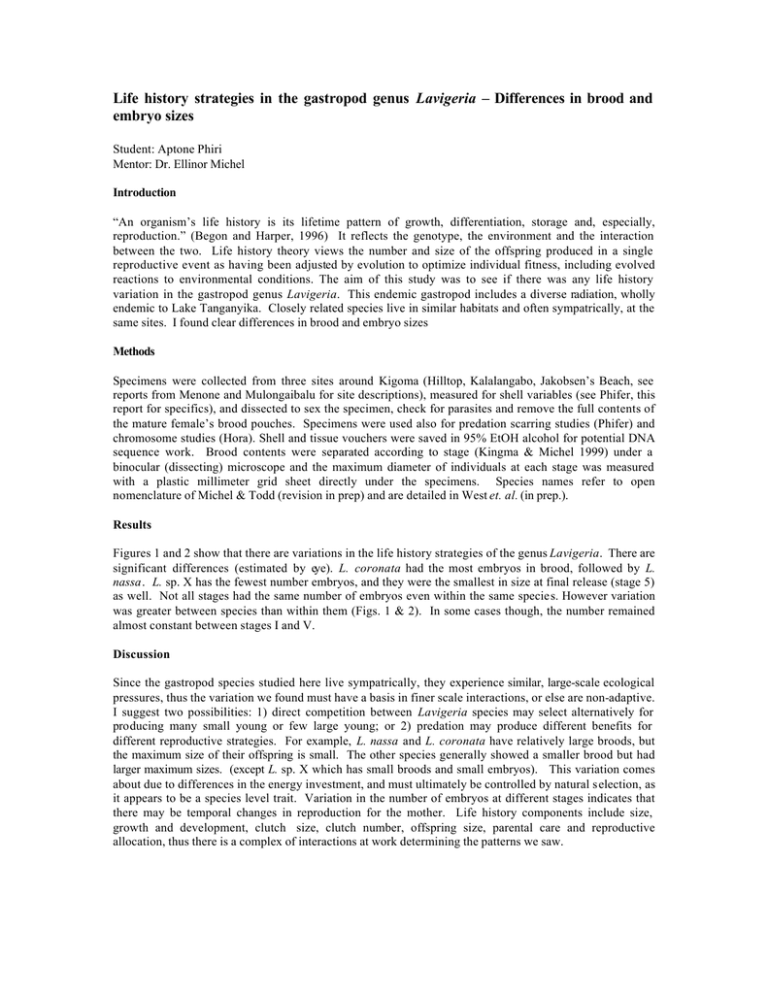
Life history strategies in the gastropod genus Lavigeria – Differences in brood and embryo sizes Student: Aptone Phiri Mentor: Dr. Ellinor Michel Introduction “An organism’s life history is its lifetime pattern of growth, differentiation, storage and, especially, reproduction.” (Begon and Harper, 1996) It reflects the genotype, the environment and the interaction between the two. Life history theory views the number and size of the offspring produced in a single reproductive event as having been adjusted by evolution to optimize individual fitness, including evolved reactions to environmental conditions. The aim of this study was to see if there was any life history variation in the gastropod genus Lavigeria. This endemic gastropod includes a diverse radiation, wholly endemic to Lake Tanganyika. Closely related species live in similar habitats and often sympatrically, at the same sites. I found clear differences in brood and embryo sizes Methods Specimens were collected from three sites around Kigoma (Hilltop, Kalalangabo, Jakobsen’s Beach, see reports from Menone and Mulongaibalu for site descriptions), measured for shell variables (see Phifer, this report for specifics), and dissected to sex the specimen, check for parasites and remove the full contents of the mature female’s brood pouches. Specimens were used also for predation scarring studies (Phifer) and chromosome studies (Hora). Shell and tissue vouchers were saved in 95% EtOH alcohol for potential DNA sequence work. Brood contents were separated according to stage (Kingma & Michel 1999) under a binocular (dissecting) microscope and the maximum diameter of individuals at each stage was measured with a plastic millimeter grid sheet directly under the specimens. Species names refer to open nomenclature of Michel & Todd (revision in prep) and are detailed in West et. al. (in prep.). Results Figures 1 and 2 show that there are variations in the life history strategies of the genus Lavigeria. There are significant differences (estimated by eye). L. coronata had the most embryos in brood, followed by L. nassa. L. sp. X has the fewest number embryos, and they were the smallest in size at final release (stage 5) as well. Not all stages had the same number of embryos even within the same species. However variation was greater between species than within them (Figs. 1 & 2). In some cases though, the number remained almost constant between stages I and V. Discussion Since the gastropod species studied here live sympatrically, they experience similar, large-scale ecological pressures, thus the variation we found must have a basis in finer scale interactions, or else are non-adaptive. I suggest two possibilities: 1) direct competition between Lavigeria species may select alternatively for producing many small young or few large young; or 2) predation may produce different benefits for different reproductive strategies. For example, L. nassa and L. coronata have relatively large broods, but the maximum size of their offspring is small. The other species generally showed a smaller brood but had larger maximum sizes. (except L. sp. X which has small broods and small embryos). This variation comes about due to differences in the energy investment, and must ultimately be controlled by natural selection, as it appears to be a species level trait. Variation in the number of embryos at different stages indicates that there may be temporal changes in reproduction for the mother. Life history components include size, growth and development, clutch size, clutch number, offspring size, parental care and reproductive allocation, thus there is a complex of interactions at work determining the patterns we saw. Table 1: Collections information for brood study Max adult Sample length Species Site Size (mm) L. sp. X HTP 51 11 L. sp. L KLG 51 16 L. sp. W KLG 48 24 L. coronata JKB 26 36 L. nassa JKB 10 24 L. grandis JKB 24 34 Figure 1 - Lavigeria Total Brood Sizes with std. errors Embryos in brood (all stages) 120 100 80 60 40 20 0 coronata grandis sp. W nassa sp. L sp. X Species Figure 2 - Brooding differences among Lavigeria species by stage 100 90 80 sp. X sp. L nassa sp. W grandis coronata 70 Number of Individuals 60 50 40 30 20 coronata grandis sp. W nassa Species 10 0 I sp. L II III IV Developmental Stage sp. X V Total (size arrayed) Conclusion Lavigeria species show interspecific variation in their life histories, specifically in the number and size of their broods. Further work should address whether large babies, such as those produced by L. grandis, survive predation better than smaller babies, such as those produced by L. coronata or L. nassa. Furthermore, growth rates and survival studies may be able to determine under what conditions competitive advantages go to few large or many small offspring in different habitats in Lake Tanganyika. Acknowledgements I would like to thank Dr. Ellinor Michel for guiding me in this project. Also I would like to thank Pete McIntyre, Megan Phifer, Chris Menone, Katja Hora, and Ellinor Michel for assisting with collecting and processing snails. References Begon, M. et al, (1996). Ecology. Blackwell Science, Ltd. Michel, E. & Todd, J. (in prep) A revision of the gastropods in the genus Lavigeria from Lake Tanganyika (Thiaridae: Cerithioidaea). Kingma, I. & Michel, E. (2000). Variation in voortplantingsstategien in het ovovivipare genus Lavigeria (Gastropoda:Thiaridae) uit het Tanga nyikameer, Oost Africa. Corresp.-blad Ned. Malac. Ver. 312:15-24. And: Life History variation in the gastropod genus Lavigeria (Thiaridae) of Lake Tanganyika (manuscript). Stearns, S. C. (1997), The Evolution of Life Histories. Oxford University Press 259pp. West, K., Michel, E., Todd, J. Brown, D., Kiza, J.P, Clabough, J. (in prep) A key to the gastropods of Lake Tanganyika, East Africa.
